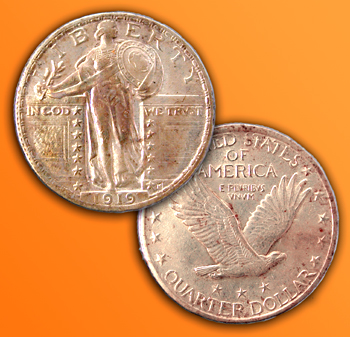The Standing Liberty Quarter, 1916-1930
|
"Making Cents"
The Signal
Saturday, October 29, 2005
| I |
I had started collecting this short-lived series during World War II, and by 1950 I had 90 percent of all the coins in my three-page Whitman folder. All were fairly well worn — some with only a partial date. In that era, coins often circulated for 30 to 50 years, and collecting obsolete issues was a challenge since people didn't save them; they spent them.
This series replaced the Barber quarters of 1892-1916. Designer Hermon A. MacNeil created the modern design to emphasize the concept of peace and liberty along with the face of a strong nation as exemplified by the shield carried by Miss Liberty. The 1916 issue came out late in the year, and only 52,000 pieces were made and released by the Philadelphia Mint.
A close look at the figure of Liberty revealed that her right breast was exposed. Naturally there was a public outcry from those who saw it and felt it obscene, inappropriate and even vulgar. The first 1917 issues also showed this nakedness. The hue and cry got to the Mint officials. By midyear the design was modified to not only cover the bare breast, but also to make some other minor modifications in the design including the addition of three stars below the eagle — thus raising the eagle in a more flight-like pose.
The 1917 Type I quarter (with bare breast) had a mintage of 8.7 million in Philadelphia, 1.5 million in Denver and 1.95 million in San Francisco. The last two are scarce in all grades today and catalogue for $20 in the lowly grade of "Good." In mint condition, they sell for hundreds of dollars.
The Type II pieces were released in the following quantities: 13.8 million from Philadelphia, 6.2 million from Denver and 5.5 million from San Francisco. The last two are fairly scarce in all grade. They catalog for $30 and $25, respectively, in lower grades, and several hundred in mint state.
The mint-marked 1917 Type I coins can be identified even without a date, since there are no stars beneath the eagle. Several of my Type I coins were dateless but in the right slot in my album.
The remainder of the series consisted of similar mintages from the three mints; however, not all years are represented. No quarters were minted in 1922, and none at the branch mints in 1923 or 1925.
In 1918, apparently a 1917 die was used for 1918, and the variety 1918-over-1917-S is now the rarest coin in the series. The mintage is unknown, but only a few hundred pieces are in collections. In the lowest grades it catalogues for more than $1,000, and in mint state well over $25,000.
In 1925 the design was modified to recess the date, since many of the 1916- to 1924-dated coins were dateless by 1925. The raised digits in the date wore off faster than expected. As a result, many of the earlier coins bring high premiums with full dates.
The more valuable coins in the series are 1919-D, 1919-S, 1921 and 1923-S. The ones I found 50 years ago were in low grades, but all identifiable. In uncirculated condition, many of these coins, including the more common dates, sell for hundreds of dollars and even many thousands of dollars for exceptionally sharp coins. Even many newly minted coins lacked some features such as the hairdo with the three leaves, all the studs on the shield, and all full skirt lines. Such "fully struck" coins bring huge premiums at auction.
Although the series was scheduled to continue past 1930, no quarters (or halves) were minted in 1931, and the Washington bicentennial (1732-1932) was coming up and a new quarter design featuring George Washington was issued in 1932, ending the Standing Liberty quarter's short tenure.
When I joined my first coin club in 1961, I proudly showed off my complete (no 1918/17-S) set of quarters and was disappointed to see that the low grade of my set was not well received by club members despite my having managed to find them all from culling through change. I eventually sold the entire set to a dealer for more than 10 times their face value.
I did buy a very nice uncirculated 1917 Type I around 1970 for $30, just to keep as a reminder of what this lovely coin featured when freshly minted. It is one of the most attractively designed U.S. coins next to the Saint-Gaudens $20 gold piece and the Walking Liberty half dollar.
Dr. Sol Taylor of Sherman Oaks is president of the Society of Lincoln Cent Collectors and author of The Standard Guide to the Lincoln Cent. Click here for ordering information.
©2005, THE SIGNAL · ALL RIGHTS RESERVED.
